Flag Protocols and Display
The United States Flag
The United States flag is considered a living thing, the union being the honor point. The right arm is the sword arm and therefore the point of danger; hence, the right is the place of honor. The edge of the flag which is toward the staff is the heraldic dexter or right edge. The union of the flag, and the flag itself when in company with other flags, is always given the honor point, i.e., the marching right, the flag's own right, or an observer's left.
Protocol and Display
As with all flags, the national flag should be raised and lowered by hand. Do not raise the flag while it is furled. Unfurl, then hoist quickly to the top of the staff. Lower it slowly and with dignity. Place no object on or cover the flag. Do not use the flag to cover a speaker's table.
Render your flag the respect it is entitled by observing the following rules:
- When displayed over the middle of the street, the flag should be suspended vertically with the union (blue field) to the north in an east and west street, or to the east in a north and south street.
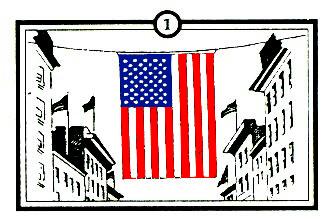
- When displayed with another flag from crossed staffs, the flag of the United States should be on the right (the flag's own right, the observer's left) and its staff should be in front of the staff of the other flag. See Rule 10 relative to displaying three or more flags under these conditions.
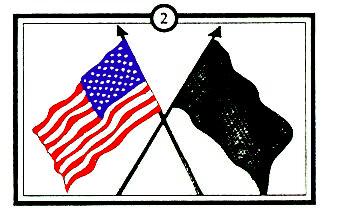
- When it is flown at half-mast, the flag should be hoisted to the peak for an instant, then lowered to the half-mast position. Before lowering the flag for the day, it should again be raised to the peak, then lowered. Half-mast is one-half the distance between the top and the bottom of the staff. On Memorial Day, display the flag at half-mast until noon, then hoist to the top of the staff.
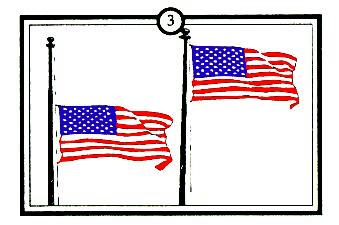
- When flags of states, cities, or pennants of societies are flown on the same halyard with the flag of the United States of America, the U.S. flag should always be at the peak. When flown from adjacent staffs, the national flag should be hoisted first and lowered last.
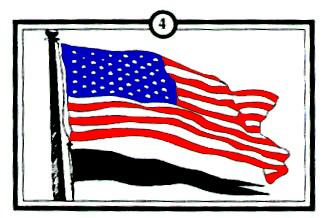
- When the flag is suspended over a sidewalk from a rope extending from house to pole at the edge of the sidewalk, the flag should be hoisted out from the building, toward the pole, union (blue field) first.
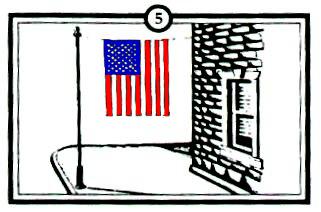
- When the flag is displayed from a staff projecting horizontally or at any angle from the window sill, balcony, or front of a building, the union (blue field) of the flag should go to the peak of the staff (unless the flag is to be displayed at half-mast).
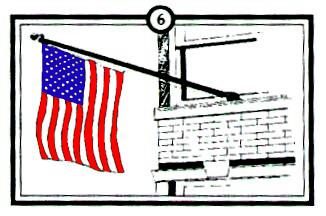
- When the flag is used to cover a casket, it should be placed so that the union (blue field) is at the head and over the left shoulder. The flag should not be lowered into the grave or allowed to touch the ground.
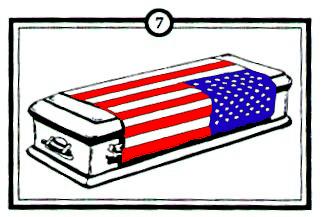
- When the flag is displayed in a manner other than being flown from a staff, it should be displayed flat, whether indoors or out. When displayed either horizontally or vertically against a wall, the union (blue field) should be upper-most and to the observer's left. When displayed in a window, it should be displayed in the same way, that is, with the union to the left of the observer in the street. When festoons, rosettes, or drapings are desired, bunting of blue, white, and red should be used, but never the flag.
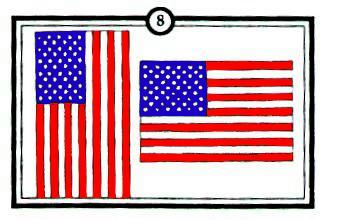
- When carried in a procession with another flag or flags, the national flag should be either on the marching right, or when there is a line of other flags, in front of the center of that line. For rules governing the position of other flags, see Flags of Nations and State of Florida Flag.
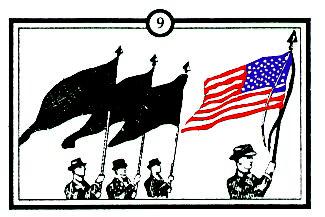
- When a number of flags of states or cities or pennants of societies are grouped and displayed from staffs with the national flag, the latter should be at the center or at the highest point of the group. For rules governing the position of other flags, see Flags of Nations and State of Florida Flag.

- When on a staff, the position of the flag is determined by the speaker, who displays it on his right (observer's left), whether he is on a platform or the same level as the audience. For rules governing the position of other flags, see Flags of Nations and State of Florida Flag.
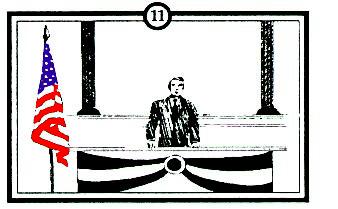
- When displayed on an automobile, the national flag always commands the honor position, i.e, highest elevation, which is always the honor point regardless of its relative position from right to left. If all flags are on the same elevation, then the honor point is the right-hand position, considered to be the flag's own right as to the directional facing. If mounted on the front fenders, the national flag would fly freely on the right-hand fender as you sit in the driver's seat. Other flags may be displayed from a multiple holder on the left-hand front fender or on the right-hand front fender with the national flag on the driver's left. For rules governing the position of other flags, see Flags of Nations and State of Florida Flag.

Other Approved Customs
Laws have been written to govern the use of flags and to insure a proper respect for them. Custom has decreed certain other observances in regard to their use.
The United States flag should be saluted on four occasions:
- during the Pledge of Allegiance
- when the National Anthem is played and the flag is displayed
- when passing in a parade or in review
- during the ceremony of hoisting or lowering the flag
Those present in uniform should render their right-hand salute. When not in uniform, men should remove their headdresses with the right hand and hold them at the left shoulder, the hand being over the heart; women should place the right hand over the heart.
The United States and Florida flags may be displayed on all days when the weather permits and should be flown especially on:
- New Years Day, January 1
- National Inauguration Day, January 20 (every four years)
- Lincoln's Birthday, February 12
- Washington's Birthday, Third Monday in February
- Easter Sunday, variable
- Mother's Day, second Sunday in May
- Armed Forces Day, third Saturday in May
- Memorial Day, Last Monday in May (half-mast until noon)
- Flag Day, June 14
- Father's Day, third Sunday in June
- Independence Day, July 4
- Labor Day, first Monday in September
- Constitution and Citizenship Day, September 17
- Columbus Day, Second Monday in October
- Navy Day, October 27
- Veteran's Day, November 11
- Thanksgiving Day, fourth Thursday in November
- Christmas Day, December 25
Other days may be proclaimed by the President of the United States. The birthdays (dates of admission) of states (Florida, March 3, 1845), state holidays, and by custom and tradition on other such days as may be directed by the Governor of Florida, should also be honored by display of the flag.
Many persons observe the custom of displaying the flag only from sunrise to sunset on outside flagpoles. Display of the flag night and day is not required to be authorized by law. There are eight places where the national flag is flown night and day officially by law:
- Fort McHenry National Monument and Historic Shrine, Baltimore, Maryland
- Flag House Square (Mary Pickersgill's "Star Spangled" House), Baltimore, Maryland
- United States Marine Corp Memorial (Iwo Jima), Arlington, Virginia
- On the Green of the Town of Lexington, Massachusetts
- The White House, Washington, D.C.
- Washington Monument, Washington, D.C.
- United States Customs Ports of Entry
- Grounds of the National Memorial Arch in Valley Forge State Park, Valley Forge, Pennsylvania
A storm flag made of bunting material should be flown during inclement weather, when display of the flags are considered appropriate.
The Florida Statutes require that the United States flag be displayed daily, when weather permits, from a staff upon the State Capitol and upon each county courthouse. It must also be flown at all designated polling places on all days when weather permits, by every publicly supported school, institution of higher learning, or other educational institution, except when closed for vacation.
Flags should never be displayed upside down except as a signal of dire distress.
Do not use flags as a portion of a costume or athletic uniform. Do not embroider them on cushions or handkerchiefs, nor print them on paper napkins or boxes.
A federal law provides that a trademark cannot be registered which consists of, or comprises, among other things, "the flag, coat of arms, or other insignia of the United States, or any simulation thereof."
When flags are used in unveiling a statue or monument, the flag should not serve as a covering of the object to be unveiled. If displayed on such occasions, do not allow the flags to fall to the ground, but carry them aloft to form a feature of the ceremony.
Take every precaution to prevent flags from becoming soiled. They should not be allowed to touch the ground or floor, or brush against objects.
The United States flag should not be dipped to any person or thing, with one exception: Navy vessels, upon receiving a salute of this type from a vessel registered by a nation formally recognized by the United States, must return the compliment.
When carried, flags should always be aloft and free, never flat or horizontal.
Never use flags as drapery of any sort whatsoever. Bunting of blue, white, and red - arranged with the blue above, the white in the middle, and the red below - should be used for such purposes of decoration as covering a speaker's desk or draping the front of a platform.
Do not use flags as a receptacle for receiving, holding, carrying, or delivering anything. Never place upon the flag, or attach to it, any mark, insignia, letter, word, figure, design, picture, or drawing of any nature.
No other flag may be flown above the national flag, except:
- the United Nations flag at U.N. Headquarters
- the church pennant, a dark blue cross on a white background, during church services conducted by naval chaplains at sea
When the flying edge of a flag becomes slightly worn, it may be mended by hemming or stitching. However, when in such condition that it is no longer a fitting emblem for display, the flag should be destroyed in a dignified way, preferably by burning it privately.
Flags of Nations
When flags of two or more nations are displayed, they are to be flown from separate staffs of the same height. The United States flag, if required, will be displayed on the right (the flag's own right, the observer's left) of all others.
When flown from separate staffs, as above, carried in a procession, grouped and displayed from staffs, displayed in the chancel or on a platform in a church, or an automobile, the following protocol should be used:
- A flag of a foreign nation displayed with the United States flag in honor of a visiting dignitary becomes the second flag in line, or position of honor, and would precede the state or city flag, except when the state or city is host to the foreign visitor. If a number of foreign visitors are being honored, their respective flags are placed according to the rank of the visitors.
- When either the state or a city is hosting, the state flag becomes the second flag in a position of honor and the visiting foreign dignitary's flag is the third in the line with the city flag fourth.
- Flags not being used to represent an official person concerned would be arranged alphabetically in the order of: state, city, and foreign flags.
State of Florida Flag
The flag of the state of Florida is usually displayed second in honor position to that of the United States. The Florida state flag becomes third when a foreign visitor is being honored in Florida by an agency or department of the United States Government or when the POW/MIA flag is displayed.
When the state of Florida is hosting a foreign dignitary, the state flag is placed second in honor position to the United States flag as the host flag and the visiting dignitary's flag is placed third in line or position of honor. Other state, city, and foreign flags not being used to represent an official person concerned are arranged alphabetically in the order of: state, city, and foreign flags.
The official flag of Florida is displayed daily when weather permits upon one building or on a suitable flagstaff upon the grounds of each state educational institution, every county school building, each elementary and secondary public school except when closed for vacation.
The Secretary of State is the custodian of the official state flag.
Chapter 256 of the Florida Statutes prohibits the placing of any work, figure, mark, picture, design, drawing, or advertisement of any nature upon any flag, standard, color, ensign, or shield of the United States or of the state of Florida. Flags so marked shall not be exposed to public view.
It is also unlawful for anyone to use the flag or state emblem, or that of the confederate states for advertising, selling, or promoting the sales of any article of merchandise within Florida. Additionally, it is unlawful to mutilate, deface, defile, or contemptuously abuse the flag or emblem of Florida or the flag or emblem of the confederate states in any way.
Individuals must not mutilate or show disrespect for any flags of the confederacy or replicas thereof.
The United Nations Flag
The United Nations flag may be displayed alone or with one or more other flags to demonstrate support of the United Nations and to further its principles and purposes.
When the United Nations flag is displayed with one or more other flags, all flags should be displayed on the same level and should be of approximately equal size.
On no account may any flag displayed with the United Nations flag be displayed on a higher level than the United Nations flag and on no account may any flag displayed with the United Nations flag be larger than the United Nations flag. When displayed with the United States flag at locations other than the United Nations Headquarters, the United States flag always commands the honor position.
The United Nations flag may be displayed on either side of any other flag without being deemed subordinated to any such flag.
The United Nations flag should never be carried flat or horizontally, but always aloft and free.
The flag should never be used as a drapery of any sort, never fastened, drawn back, nor up, in folds, but always allowed to fall free.
In a closed circle of flags, flags other than the United Nations flag, should be displayed in the English alphabetical order of the countries represented by the flags reading clockwise. The flagpole immediately opposite the main entrance of the main building determines the beginning of the circle.
In line, cluster, or semi-circle groupings, all flags other than the United Nations flag should be displayed in the English alphabetical order of the countries represented by the flags starting from left and reading clockwise. The United Nations flag should either be displayed in the center of the line, cluster, or semi-circle, or, in cases where two United Nations flags are available, at either end of the line, cluster, or semi-circle.
The national flag of the country in which the display takes place should appear in its normal position according to the English alphabetical order.
When the country in which the display takes place wishes to make a special display of its national flag, such a display can only be made where the arrangement of the flags takes the form of a line, cluster, or semi-circle grouping, in which case the national flag of the country in which the display is taking place should be displayed at each end of the line of flags separated from the grouping by an interval of not less that one-fifth of the total length of the line.
Authorities: Office of Armed Forces Information and Education; Department of Defense; United States Marine Corps Flag Manual; United Nations Flag Code and Regulations as amended July 28, 1950; The Institute of Heraldry, United States Army.
